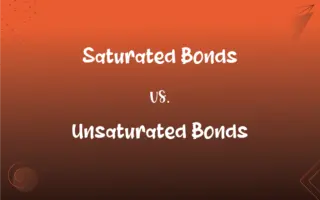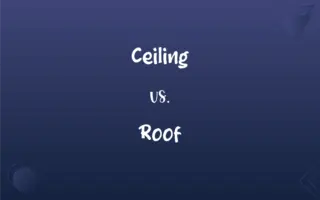Sparkle vs. Twinkle: What's the Difference?
Edited by Aimie Carlson || By Harlon Moss || Published on January 11, 2024
"Sparkle" implies a bright, often rapid display of light or brilliance, while "twinkle" refers to a softer, intermittent flickering of light.

Key Differences
Sparkle generally denotes a bright, vivid, and often lively display of light. It suggests an energetic or dazzling quality, like diamonds sparkling under a light. Twinkle, in contrast, refers to a gentler, often rhythmic and intermittent flickering of light. It's commonly used to describe stars or distant lights, conveying a sense of softness and subtlety.
In terms of visual impression, sparkle often conveys a sense of multiple points of light, creating a radiant or shimmering effect. It's associated with clarity, brilliance, and often with movement. For instance, sunlight reflecting off water might be described as sparkling. Twinkle, however, suggests a more singular, rhythmic blinking or flickering effect, like the twinkle of a star. It often conveys a sense of distance or delicateness.
Sparkle can also be used metaphorically to describe vivacity or liveliness in personality or appearance. A person's eyes might sparkle with excitement, indicating a dynamic or energetic quality. Twinkle, when used metaphorically, often conveys a sense of playfulness, charm, or subtle humor, such as a twinkle in someone's eye when they're being mischievous.
In literature and poetry, sparkle is often used to create imagery that is vivid, bright, and dynamic. It suggests an element of glamour or enchantment. Twinkle, in literary use, often aims to evoke a sense of wonder, magic, or a gentle, soothing quality, aligning with its softer, more rhythmic nature.
Sparkle can also refer to a brief, sharp reflection of light, suggesting a momentary or fleeting quality, like the sparkle of a gemstone. Twinkle, on the other hand, implies a more sustained, periodic light emission, like the continuous, rhythmic twinkling of stars in the night sky.
ADVERTISEMENT
Comparison Chart
Visual Quality
Bright, radiant, shimmering
Softer, rhythmic flickering
Frequency
Rapid, often continuous
Intermittent, rhythmic
Connotation
Energetic, lively, dazzling
Gentle, subtle, playful
Metaphorical Use
Vivacity, brilliance in nature
Charm, whimsy, subtlety in nature
Common Usage
Describing gems, reflective surfaces
Describing stars, distant lights
ADVERTISEMENT
Sparkle and Twinkle Definitions
Sparkle
Bright light reflection.
The diamond ring sparkled under the showroom lights.
Twinkle
Subtle hint of light.
There was a twinkle in his eye as he told the joke.
Sparkle
Shimmering effect.
The surface of the lake sparkled with the reflection of stars.
Twinkle
Rhythmic light variation.
The candle flame twinkled in the breeze.
Sparkle
Vibrant personality.
Her vibrant personality sparkled at the party.
Twinkle
Gentle sparkling.
The distant city lights twinkled at night.
Sparkle
Emitting small flashes of light.
The fairy lights sparkled in the dark room.
Twinkle
Soft gleam.
Her necklace twinkled softly in the dim light.
Sparkle
Glittering appearance.
The frost on the window sparkled in the morning sun.
Twinkle
Intermittent light flicker.
The stars twinkled in the night sky.
Sparkle
To give off sparks.
Twinkle
To shine with slight, intermittent gleams, as distant lights or stars; flicker; glimmer.
FAQs
Are sparkle and twinkle interchangeable?
Not always, as they imply different intensities and qualities of light.
Can sparkle be used to describe sound?
Rarely, it's mostly used for visual descriptions.
Is twinkle specific to stars?
While commonly used for stars, it can describe any gentle, intermittent light.
Is sparkle always bright?
Generally, it implies brightness and brilliance.
Does sparkle imply movement?
Often, as it suggests a dynamic quality of light.
Can sparkle denote energy?
Yes, especially in describing personalities or lively environments.
Can twinkle be steady?
No, it inherently suggests a flickering quality.
Can twinkle be used metaphorically?
Yes, often to describe subtle charm or playfulness.
Can sparkle be used in a negative context?
Rarely, as it usually conveys positivity and brightness.
Is sparkle only for visual descriptions?
Primarily, though it can metaphorically describe other sensations.
Is twinkle always positive?
Mostly, but context can influence its interpretation.
Can twinkle be loud or intense?
No, it typically implies a softer, more subdued light.
Does sparkle suggest luxury?
It can, especially in the context of precious stones or glamorous settings.
Is sparkle a common term in poetry?
Yes, for its vivid and lively imagery.
Does twinkle imply distance?
Often, as in the twinkling of distant stars.
Can both terms be used in scientific contexts?
Yes, but more commonly in descriptive, rather than technical, language.
Does twinkle imply a pattern?
It often suggests a rhythmic or repeating pattern of light.
Is twinkle a soft or harsh light?
It's typically described as soft and gentle.
Can twinkle have a magical connotation?
Yes, it's often used in fairy tales and fantasy to evoke a sense of wonder.
Can inanimate objects sparkle?
Yes, especially reflective or shiny surfaces.
About Author
Written by
Harlon MossHarlon is a seasoned quality moderator and accomplished content writer for Difference Wiki. An alumnus of the prestigious University of California, he earned his degree in Computer Science. Leveraging his academic background, Harlon brings a meticulous and informed perspective to his work, ensuring content accuracy and excellence.
Edited by
Aimie CarlsonAimie Carlson, holding a master's degree in English literature, is a fervent English language enthusiast. She lends her writing talents to Difference Wiki, a prominent website that specializes in comparisons, offering readers insightful analyses that both captivate and inform.































































